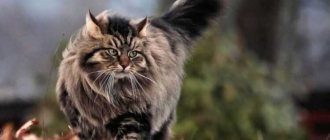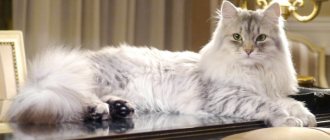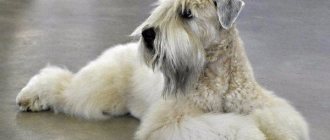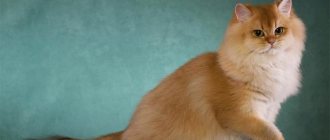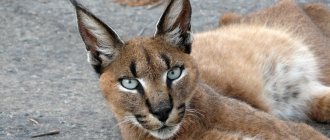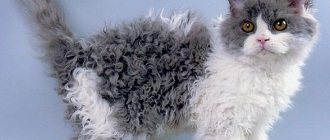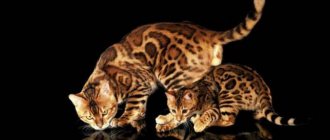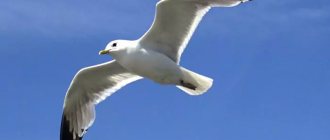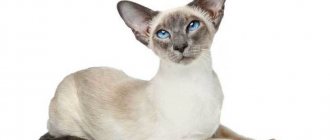Napoleon cats are miniature animals, distinguished by their calm disposition and unusual appearance. If you want to have an unusual pet, then get ready to shell out a large sum, since this cat breed is considered one of the most expensive. The name of the cat is directly related to the name of the famous commander Napoleon, who was notable for his short stature.
Origin story
For the first time, the idea of breeding cats with short legs and a baby-face muzzle came to American dog breeder Joe Smith in 1995. Having seen the Munchkin, the breeder was inspired by the idea of creating a new breed based on it, without resorting to experiments with the genome. He imagined that the short-legged pet would become more charming, acquiring the charming face of a Persian cat. The breeder's goal was to maintain the good health of the Munchkin Persian. That is why it was decided to avoid gene mutations (the genes of Persian cats could cause hereditary diseases and imperfections).
In his work, Joe used both subspecies of the munchkin - standard and short-legged. As a result, two varieties of the Napoleon breed were created: classic and extreme.
The new cats were presented to professional experts, but only TICA (International Cat Association) was willing to register the new breed. The rest sent a refusal, expressing the opinion that the breed was apparently not viable. The upset breeder became disillusioned with the idea and gave away the kittens that were born, deciding to stop further work.
But the baton was not allowed to fall from his weakened hands. Breeders Sam Tate, Margie Gardner, Terry Harris decided to continue working with the kids, considering the new breed promising. They managed to finish the job and get pets with the required breed data, without resorting to changing the genotype.
As a result, the Napoleon cat breed was registered in two organizations - TICA (USA) and ASSOLUX (Russia). In 2015, it was decided to change the name of the breed to a more suitable one – minuet (small).
Knitting features
Napoleons, despite their small size, become sexually mature by 6–8 months. But by this time the body has not yet fully formed, so mating should be postponed. If the owner intends to spay/castrate the animal, then this is best done at the age of 6–10 months, while the body is still building hormonal chains.
The optimal time for mating is when the cat is between one and a half years old. Cats can be bred from the age of one year.
Napoleons can be bred within the breed. TICA standards also allow crossbreeding with related cat breeds:
- Persian;
- munchkin;
- exotic shorthair;
- Himalayan
The offspring will have good health and no defects. Crossing with other breeds does not guarantee the desired result.
Pregnancy in cats lasts 63–65 days. Up to five cubs are usually born. Napoleons are good mothers; they feed and lick their kittens for one and a half to two months.
The color of the offspring usually completely matches the color of the parents
Napoleon breeding business
The new and rare breed is highly prized. Therefore, the business of breeding Napoleons can be considered economically justified. In addition, cats are easy to care for and bring a lot of joy with their games and affection.
Difficulties may arise when choosing pets: today there are few professional breeders, you can easily run into scammers who, under the guise of an expensive Napoleon, will sell mestizo of other breeds. The new breed has not yet fully consolidated its typical properties at the genetic level - because of this, the appearance of defective offspring is possible (for example, long legs in kittens or problems with tear production).
Standards
Cats of the Napoleon (Minuet) breed are a type of superminiature. The body weight of animals of the extreme subspecies rarely exceeds 1.5-2 kg, height at the withers is 20 cm (the classic subspecies weighs up to 4 kg). But in their category, these cats have an athletic build, strong bones and a developed muscle corset. The breed standard of the TICA Association gives the following characteristic appearance features:
- Napoleon's head is large, with softly rounded features. Features include rounded cheeks, a small chin and cheekbones. Thanks to their round eyes, short nose, and small break (notch on the bridge of the nose), these cats have a peculiar childish facial expression (baby face).
- The wide-set eyes are shaped like a round hazel. They are large, bright, slightly bulging.
- The ears are medium in size, triangular, well-furred, set wide apart, with rounded ends, without tufts.
- The bridge of the nose is wide, short, the snub nose is not as pronounced as in the Persians (thanks to this, Napoleons have no problems breathing), the nose is pink.
- The neck is muscular and short.
- The body is elongated, the back is flat and wide.
- The length of the paws determines the type of breed. The classic type Napoleon has a standard paw length, while the extreme type variety has greatly shortened limbs. The front ones are straight and strong. The hind legs are slightly longer, which is why the cat seems to fall on its front legs. The paws are large. The interdigital space is well pubescent.
- The tail is very long (longer than the body length), wide, and in long-haired animals it is densely pubescent.
Possible defects in appearance: pronounced brow ridges. Excessively long limbs, pronounced breaks, a deviated nasal septum, and lacrimation lead to the disqualification of the pet.
What does a pet look like?
Distinctive features of the appearance of Napoleon cats:
- compact dimensions;
- low body weight (females weigh up to 2 kg, males reach 2.5-3 kg);
- flattened round face;
- large round eyes;
- short, slightly flattened nose;
- small pointed ears;
- developed, neat chin;
- stocky build;
- elongated body;
- developed hips and shoulders;
- fluffy long tail.
Among the representatives of the miniature breed there are both long-haired individuals and less fluffy, “plush” males and females. The colors of Napoleon cats are varied. Sometimes animal fur contains contrasting shades.
Cats of the breed in question are divided into two types - classic, with paws of standard length, and dwarf (Napoleon-extreme). A distinctive feature of the second variety of pets is their short legs (half as long as those of ordinary cats). Compared to the first type, these animals are traditionally more expensive.
Colors
Depending on the type of hair, Napoleon cats are divided into subspecies:
- Long-haired - very fluffy, the outer hair reaches 5-6 cm. There is a thick undercoat.
- Semi-longhaired - have hair up to 3 cm long. The undercoat is also very pronounced.
- Shorthairs have short plush hair and small down.
The standard allows any coat color. The most common combination of several colors is: tabby, bicolor, color point and others.
The history of the Napoleon cat breed
There is a version that the name of this variety was given because of its dwarf size and the fact that the well-known military leader and Emperor of France Napoleon Bonaparte was also not very tall, and he also had a phobia associated with cats - he was very afraid of them. This disease is called Gatophobia.
These unusual representatives of the cat world were bred quite recently. Cats of the Munchiquin breed and long-haired Persians, which are distinguished by their extraordinary grace, took part in the selection work. The breed was registered only in 2011 and its price is determined by the costs that were incurred in the process of its breeding. At the same time, specialists not only wanted to breed a pet with miniature paws, but also one with a healthy body, devoid of “defects.”
It all happened at the end of the 20th century, when the American cat breeder Joe Smith set out to get an exotic cat with the set parameters. At first there was no talk of the success of this work, since the genotype of Persian cats was not suitable for crossing for a number of parameters. The kittens that were born at the same time had serious defects.
But the dedicated and enthusiastic breeder Joe Smith, after carrying out careful work on further research of the genotype, was able to obtain several pets in 1996 of this rare variety that did not have gene mutations. After this, the breeder contacted the international feline association TICA to add his new breed to the Experimental Breeds collection. By 2002, the species' status had just been registered, but he abandoned the project in 2008, stopped further research into the field of crossing, and neutered all of his remaining individuals. However, the cats that were born were so unusually cute that interested breeders began to continue the work a whole decade later. As a result of their work, the Napoleon cat variety gained not only its uniqueness, but also received official recognition in TICA.
Character and behavior
Napoleon (minuet) cats are a breed that is completely human-oriented. Unlike the Persians, in their character there is no desire to be capricious, or some arrogance. Both internally and externally, they remain kittens until old age: small size, playfulness, desire for affection. They are perfect as a companion for families with small children. Cats get along well with kids. These are soft, non-touchy animals; they spend hours next to the child, cheering, calming, and entertaining.
Loneliness is unacceptable for these cats. Before buying a baby, the owner is advised to ensure that the cat is not left alone in the house. As an option, it is recommended to have other pets. It will be easier for everyone together to pass the painful hours while the owners are away. Napoleons are not aggressive at all. Thanks to their sociable nature, they easily find a common language with all household members, including other cats and dogs. Despite their short legs, cats are active, run quite quickly, love to climb, and short legs are not a hindrance for them. They bring harmony and tranquility to the family, relieve fatigue, and cheer up.
Napoleon's sociability is often the reason for excessive gullibility. The cat calmly goes into the arms of strangers, which the owners do not always like.
Raising and training a pet
Napoleons are aristocratic cats. Thanks to their innate intelligence, they are quick-witted and therefore amenable to training. They have access to the initial level of training, which includes learning simple commands.
Something else interesting: cats with high levels of intelligence
Intelligence is very important when socializing kittens. When they first get into the house, they quickly master the wisdom of family life. Very soon they learn to use the toilet and scratching post, remember their diet, and know what is possible and what is not. These cats have a natural breeding that is given to them with their mother's milk.
Cute little bundle
Each kitten can present its owners with a lot of interesting facts about its behavior.
There is an opinion that Napoleons help a person get rid of fatigue and stress, overcome muscle pain and headaches.
Their full, round muzzle with huge, round, wide-set eyes will not leave any fan of furballs indifferent.
Even looking at the photo of the Napoleon cat, you just want to hug this fluffy little ball to your chest and never let go.
Care instructions
Caring for baby Napoleons is simple and includes standard procedures.
Wool
The main means of keeping the coat in order is frequent combing of pets. This is especially true for long-haired cats. They are brushed daily. For short-haired people, the procedure is carried out 2-3 times a week. Thus, the hair follicles are massaged, lost hairs are removed, and the formation of tangles is prevented.
Accessories for grooming are purchased at a specialized store. This is a massage mitten brush, a brush with natural bristles and a comb with long teeth. Scratch carefully, trying not to cause pain. Follow the direction from the head down (the tail is combed last). When combing, try to capture the entire length of the hair, including the undercoat.
Bathing
Napoleon cats are bathed rarely - 3-4 times a year. This breed is distinguished by its loyal attitude towards water. If you accustom your pet to the bathing procedure from early childhood, then in the future it will bring only pleasant emotions. Use shampoo for long-haired cats in combination with conditioner. The following brands are suitable: “ZOO”, “Bars”, “Doctor”. When finished, dry the wool thoroughly with a towel and then with a hairdryer. After bathing, the animal should be in a warm room.
Claws
Nail care is simplified if your pet is trained to use a scratching post. In this case, he successfully grinds off the overgrown claws on his own, and the owner can only occasionally correct them with the help of a nail clipper. The procedure is not pleasant, so you should be accustomed to it from early childhood. The main thing is not to cause pain to your pet when performing a manicure, so that the procedure does not cause fear and unpleasant associations.
Ears and eyes
Ear cleaning is done weekly. Chamomile decoction or boric acid solution are suitable as a cleanser. If wax deposits in the ear canal are significant, a special lotion is used to dissolve ear deposits. The following brands are effective: “Ushastik”, “Otoklin”, “Ms.KISS”.
The eyes are examined daily and, if necessary, cleaned of foreign matter and secretions (cats of this breed often suffer from tearfulness), moving from the outer corners to the nose. You should carefully monitor the health of the mucous membranes. An indicator of eye health is the absence of wet hair and tear tracks.
Teeth
To brush your teeth, use a small toothbrush and toothpaste or special dental lotion. If problems arise with oral hygiene, then use a cleansing gel, which is added to drinking water. To clean the interdental spaces, cats are given special hard treats to chew on. If plaque is present, it can be removed using a laser method in a veterinary clinic.
Education and physical activity
By nature, Napoleons are intellectual and easily amenable to education. Kids quickly remember where the tray is and quickly begin to respond to their name. At a young age, you can teach your pet simple household commands that will facilitate your communication with him.
Despite their small size, most Napoleons are very active and playful. They enjoy frolicking with children or other animals. They love to climb onto low backs of chairs, sofas or shelves.
It is necessary to provide pets with toys so that they can splash out their energy reserves on their own.
Napoleons get along well with other animals
Catering
The Napoleon cat is one of the animals prone to overeating. You should carefully monitor her diet and control the portion size. In addition, children should be encouraged to engage in sufficient physical activity. All this will help maintain normal body weight, health and activity for many years. Long-haired pets, while licking themselves, swallow their own fur. Along with food, they are offered a special paste that helps remove trichobezoars (hairballs) from the stomach.
Something else interesting: how to choose the right diet and how much food does a cat need per day?
For minuet, feeding both dry, industrial food and natural food is acceptable. Some owners prefer a mixed type of diet for their pets, although not all veterinarians approve of this regimen. It is very important that the diet is balanced and helps compensate for the deficiency of all nutrients and vitamins. Constant access to clean and fresh water is very important for Napoleon.
Natural products
As with all obligate carnivores, the most important ingredient in the diet for Napoleons is meat. All types of meat are suitable for them, except pork (rabbit, turkey, chicken, beef, veal). The meat is given raw, frozen for 24 hours to eliminate helminths. Additional ingredients are also important. They will help make your diet complete and varied:
- offal (liver, stomachs, hearts);
- fermented milk products (low-fat kefir, yogurt, sour cream, cottage cheese);
- sea fish (once a week);
- egg yolks (once a week);
- Porridge with water (buckwheat, rice, oats, millet);
- vegetables (zucchini, carrots, cabbage, pumpkin, greens).
Something else interesting: DIY cat food recipes
Recommended food
From dry food you should choose only high-quality, holistic, super-premium, where the ingredients are only high-quality and well-balanced. This will help avoid possible side effects from preservatives, dyes, and flavor enhancers contained in cheap food. The following brands of food are suitable:
- Grandorf;
- Primordial;
- Fitmin Purity.
Maintenance and care
Napoleons are exclusively domestic cats that do not need regular, much less free walking. If you want to introduce your cat to the street, you only need to walk on a harness under close supervision. It is worth taking into account minor features of keeping representatives of the breed associated with their small size and short legs. For example, the litter box should have low sides, and the cozy bed may be smaller than for most breeds. Kittens require increased attention in terms of maintenance and care.
Napoleons do not require specific care; it all comes down to a list of the most necessary procedures: combing, bathing, hygiene of the eyes, ears, oral cavity and trimming of claws as desired or necessary. The regularity of brushing depends on the quality and length of the coat. The frequency of bathing is individual, usually once every six months. Shampoos and conditioners are selected based on coat type. Blow-drying is acceptable, but not recommended.
For long-haired animals, special pastes or food for removing hair are recommended.
Check eyes and ears regularly and clean them as needed. The problem with claws is usually solved by purchasing and taming the kitten to a scratching post.
Feeding
A few breeders of Napoleon cats feed their pets with ready-made super-premium or holistic class dry food. Some people practice a mixed diet, adding meat and dairy products to the main diet. When choosing food for your pet, you should take into account its age, coat length, physiological state (pregnancy, lactation), illness and, of course, taste preferences.
Diseases
Napoleon is a cat with good health potential, but a tendency to some serious pathologies still exists. Like any hybrid breed, animals have the possibility of mutations. Due to genetic failures, healthy parents have had cases of kittens being born with deformities or congenital pathologies. The following diseases are most often diagnosed in the Minuet cat:
- Kidney problems. The disease begins with polycystic kidney disease, which is complicated by renal failure. The disease can be successfully treated only with timely diagnosis.
- Cardiomyopathy. The pathology does not appear for a long time. The first symptoms appear already at a late stage. Abnormalities in the heart can only be eliminated surgically.
- Retinal atrophy. Diagnosed in kittens. If left untreated, the disease ends in complete blindness.
There may also be problems with teeth, with the spine (lordosis), problems with the eyes (entropion of the eyelids, cataracts). Fortunately, breathing problems are rarely reported in cats of this breed.
Conclusions about the breed
What conclusions can be drawn about the miniature cat Napoleon? If we compare the advantages and disadvantages, we will make the following verdict:
- Excessive friendliness has a downside: the cat is often lonely, you need to play with it a lot, talk to it and simply pet it endlessly. If the owners are rare guests in their home, the breed is not for them.
- The cat is affectionate, you don’t have to worry about children and animals.
- If the cat's pedigree is impeccable, he will enjoy good health. Of course, with the right content.
- Maintenance is simple and not complicated. The main thing is to feed him well and keep his coat, eyes and ears clean.
Beautiful, playful and funny cat Minuet is waiting for her portion of admiration!
global $ads_google; //data-ad-slot=”2475549904″ $ads_google = empty($ads_google) ? false : true; ?> if ($ads_google == false) {?>
$ads_google = true; ?> } ?>
Tips for choosing a Napoleon kitten
Recently, there have been professional nurseries in Russia where they breed Napoleon cats. If you want to buy a kitten, you should contact such a nursery. You should not buy it from your own hands, as there is a high risk of getting a sick animal. The difficulty is that there are strict requirements for breeding Napoleons. They can only be accomplished with a professional attitude to the matter. Matings can only be carried out in this way:
- Napoleon and Napoleon;
- Napoleon and Persian cat or exotic.
Mating a Napoleon and a Munchkin is undesirable, since kittens with conformation defects may be born. Inbreeding is not allowed; there is a threat of dangerous mutations and diseases.
When purchasing, it is important to check the pedigrees of both parents. This will ensure the purchase of a healthy kitten with a high probability. You should also pay attention to what the kitten looks like and in what conditions it is kept in the nursery.
How much does it cost and where to buy
Since Napoleons have only recently been bred in Russia, here you can only count on a pet class pet (pet). Such a kitten costs from 30 to 70 thousand rubles. Breeding of show class animals is currently carried out only in America. Their price can reach up to several thousand dollars.
Price and where to buy Napoleon kitten
The Napoleon breed is considered exotic, and therefore is expensive. It's nice to have a friendly, sophisticated exclusive! And this is exclusive because breeding such a cat without hereditary health problems is not as easy as one would like. Only a professional can do this.
In Russia there are nurseries specializing in breeding Napoleons. To create, as usual, a Persian cat and a munchkin are taken. Excellent pedigree of both lines is required to produce healthy offspring without abnormalities.
A Napoleon kitten costs 30,000-50,000 rubles. A small fluffy exclusive can be purchased at the Bronze Breeze nursery (Moscow, Russia).
Also, the miniature purr can be found in foreign nurseries.
How to name minuet kittens
A cat that appears like a kitten until old age is usually adored by everyone in the family.
But choosing a name for a baby is sometimes difficult. Too soft will seem like excessive lisp. Ordinary will not add charm either. This means that the nickname should be euphonious, beautiful, and a little soft. There is no need to give a brutal name even to a boy. To prevent choosing a nickname for kittens from becoming painful, we suggest that you familiarize yourself with the list of suitable names for funny exotic cats. Nickname table
| Girl | Boy | ||
| Lada Anta Lola Priora Villa Belka Zirsa Snezha Gala Nika | Dulya Yolka Inza Rina Nyusya Vasena Aisha Murlysya Yuska Bentley | Boatswain Khariton Star Elizar Sauron Eros Khan Adonis Boris Vermut | Antey Mario Karabas Love Lavrentiy Zephyr Ruby Spark Guidon Karat |
Advantages and disadvantages
Owners and breeders of Napoleon cats highlight the following advantages of their pets:
- people-oriented;
- lack of aggression;
- love for children;
- friendliness and desire to communicate;
- ability to get along with other pets;
- original appearance;
- The compact size of the cats allows you to take them with you on trips.
The most significant disadvantages are:
- inability to be alone;
- the likelihood of hereditary diseases and mutations;
- high price of kittens;
- the presence of serious restrictions on breeding pets;
- the need to control diet due to a tendency to obesity
Health
The high cost of Napoleon kittens is explained by the difficulties of breeding. Even when mating first-class sires, there is a high risk of having inferior offspring. We are talking about congenital deformities, abnormal bone structure, or the death of offspring for unexplained reasons. Napoleons live 10–12 years and are not in good health, because the breed is a carrier of a mutation and a hybrid.
Important! Do not purchase a kitten from a breeder if they refuse to provide you with written (!) documents about the animal’s health status! Not only vaccinations, but also examinations for physiological disorders, a conclusion from a breed expert and a letter of guarantee from the breeder!
Character of miniature animals
The temperament of these cats matches their appearance very well. Napoleons are very affectionate and gentle creatures; aggression is completely uncharacteristic for them. They are loyal to their owners and really need constant communication and self-love.
Little cats are endowed with patience. This breed is often recommended for families with children. Napoleons get along well with children and do not scratch even for self-defense. In addition, these cats are very sensitive to changes in people’s moods; they are ready to share joy and silently give love in difficult times.
Minuets are distinguished by quick wit and intelligence. They are happy to be trained and even remember simple commands with ease. Kittens quickly remember their name.
Napoleons also get along easily with other animals that do not show aggression. If there is a hamster or parrot in the house, cats do not try to hunt small animals; they have almost no feline hunting instinct.
Napoleons are a very social breed, they cannot be left alone for a long time, they require the attention of the owner, or a companion in the person of another pet.
It is worth noting that this breed of cat loves its home and does not seek to sneak out into the street when the opportunity arises. Getting into the wild poses a huge danger for them, so it is not recommended to let minuets go on long walks on their own.
Napoleons need constant communication
The cost of little fidgets
The price for Oriental cats ranges from 25,000 rubles per kitten aged 2 months to 45-60 thousand. It all depends on the class of the animal, the quality of the breed, wool, color. The most expensive are breeding cats. They can cost up to hundreds of thousands of rubles.
Any cattery of oriental cats has not only breeding, but also sale pets. These are individuals with some breed flaws, different colors, but also beautiful in their own way.
You can purchase such pets at a lower price and raise a wonderful fidgety cat or female cat.
The original appearance of Orientals attracts people with unusually shaped ears, almond-shaped eyes, slender body and grace. No one can remain indifferent to this breed. The main thing is to love your pet and raise it correctly.
